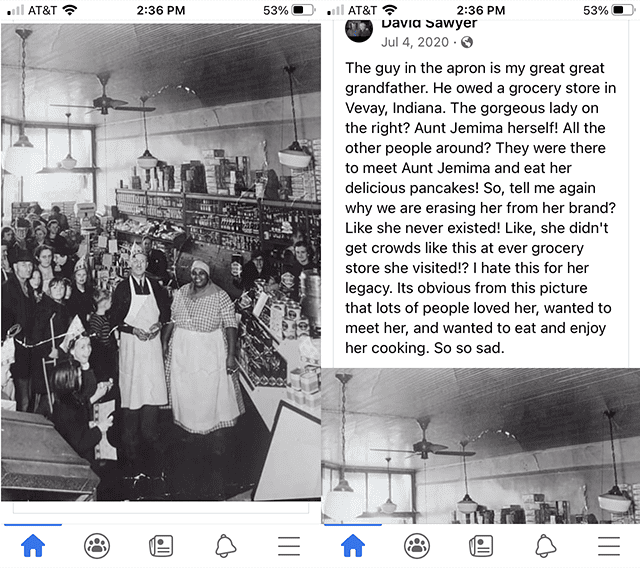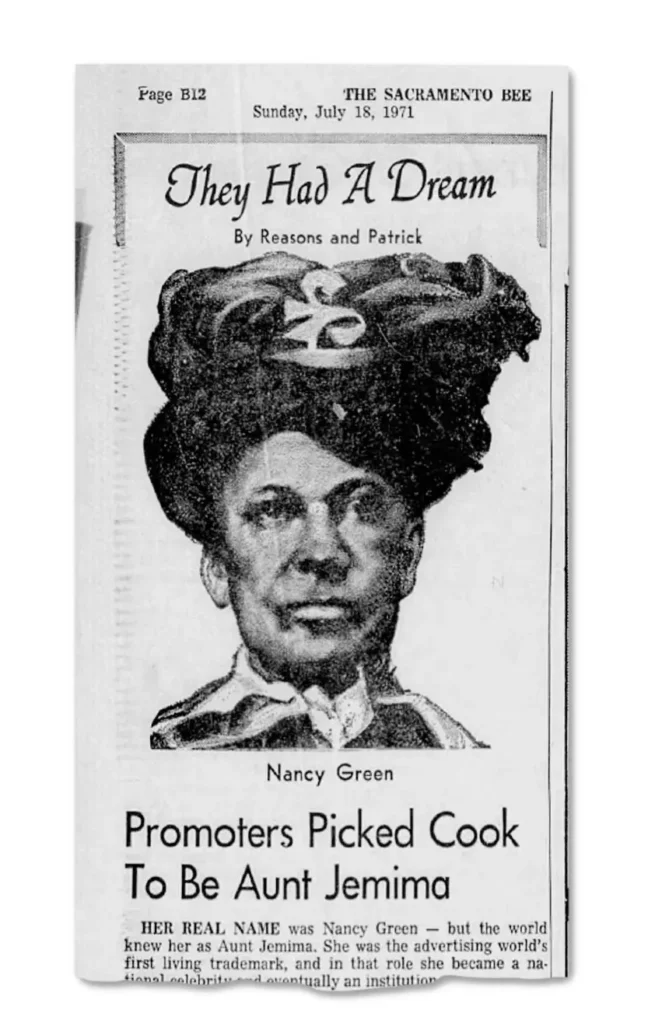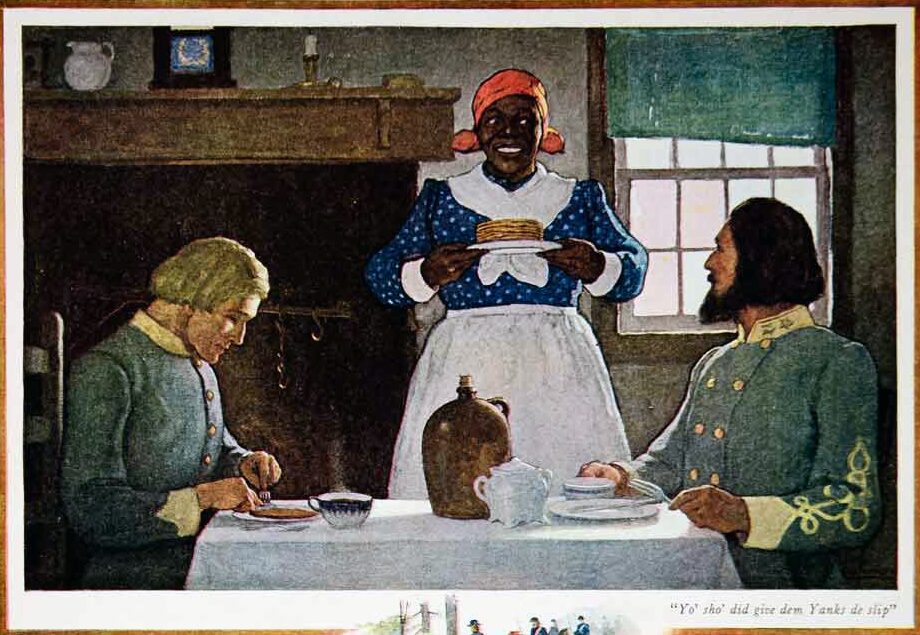A Case Study in Historical Misinformation and “Cancel Culture”
I recently saw an Instagram post claiming to celebrate Nancy Green, the first woman to portray the fictional, Aunt Jemima character. Various false versions of Green’s story throughout social media make her out to be a pioneering Black entrepreneur, or at least a well-paid and popular spokesmodel. They make for inspiring narratives, except for the fact that they aren’t true.
The reality of Green’s life, and the dehumanizing figure she sometimes pretended to be, is far more unsettling. Aunt Jemima is deeply intertwined in the legacy of White Supremacy and Green, like most African Americans of her time and later, had to make the difficult choice to be a part of perpetuating White Supremacist fairytales or watching while someone else got paid to do it.

One thing the viral posts usually get right, Nancy Green was a formerly enslaved woman. But that’s about it. Nancy Green was an impoverished domestic servant who spent the majority of her life working for wealthy white families. Sometimes she also got paid to promote a racist icon. She was not the creator of Aunt Jemima; nor did she play any role in running the business; nor did she make a living portraying the most famous “Mammy” in American History, let alone a good living.
Green was first hired to be the living embodiment of Aunt Jemima during the 1893 World’s Columbian Exposition, in Chicago. The exposition celebrated 400 years since Christopher Columbus first arrived in what he believed to be India. The entire exposition was marred by racism in many ways, not least of which was the assumption that Columbus deserved praise for his inability to even know where he was. The grinding down of indigenous communities throughout what is now called, “The Americas,” and the complete loss of numerous civilizations, along with hundreds of years of importing Africans and keeping them in perpetual bondage, were not the kind of stories the beautiful, “White City,” was constructed to tell. But the exposition also featured the first Ferris Wheel, created by George Washington Gale Ferris, Jr., to rival the hit of the 1889 World’s Fair in Paris, the Eiffel Tower. So it wasn’t all about White Supremacy.

For her part, Green proved to be a gifted entertainer. The audiences that came to see, “Aunt Jemima,” didn’t just want demonstrations on how to cook pancakes; they wanted to be regaled with songs and stories of her childhood in slavery. Not the harsh realities and daily indignities of slavery, of course, but romanticized, glossy narratives that presented an idealized version of the antebellum South. This kind of nostalgic, comforting marketing campaign — that exploits a longing for a past that never existed — is not uncommon. Majorities rarely want to hear about the bad parts of their history. Happy, but not so bright mammies and other minstrel show characters were a huge part of how White America kept themselves willfully ignorant, yet smugly superior for generations.
Green continued working as a housekeeper and cook until her death in 1923, with no evidence she significantly profited from her appearances as a pancake mascot. Nor was she seen as the embodiment of Aunt Jemima, with any power or agency to demand better pay. In 1900, when she refused to cross the Atlantic to attend another exhibition in Paris, she was replaced by Agnes Moodey, who was presented as the original Aunt Jemima.


As previously alluded to, the origins of the fictional Aunt Jemima persona get into some of the ugliest aspects of American History. Racist minstrel shows thrived in the 1800s, often times with White Actors in Blackface presenting the most extreme and dehumanized versions of, “Negroes.” Or some other N-word. One of the standard characters in these shows was the ever-grinning “Mammy,” who was so devoted to her White Family that even after emancipation her only desire in life was to serve. The businessmen who created the Aunt Jemima brand capitalized on this insidious image, which so many mistook as historically accurate.
The misinformation circulating about Green today is more than just a social media fable. These are dangerous and disgusting misrepresentations of the past designed to make White Americans feel better, just as the Aunt Jemima character once did. They invite Whites to continue to hold tight to historical inaccuracies and the false security they bring, at the expense of Nancy Green and countless other people of color.
What is especially inside-out, upside-down, backwards, and profoundly nonsensical about the false versions of Nancy Green on social media, are the claims that Green has been, “erased,” and the removal of the Aunt Jemima brand from shelves is the result of, “cancel culture.”
Nancy Green was not erased from history; she was exploited by those who had the power to manufacture fake history. The Aunt Jemima character was a racist caricature, not a figure of empowerment. Portraying Green’s involvement as some entrepreneurial success story degrades reality and exploits Green all over again.
The retiring of the Aunt Jemima brand was a long overdue course-correction, not an act of censorship. If anything, the brand itself erased Green’s true identity, and the identity of countless others, by repeatedly telling people of color, “We don’t want to know you. We want you to play the roles we are comfortable with.”
It’s the misinformation circulating on social media that is attempting to rewrite history and erase the disturbing truth behind Aunt Jemima’s origins. Removing racist imagery is the opposite of “cancel culture.” It’s acknowledging the harm caused by the normalization of dehumanizing stereotypes for corporate profit. True cancel culture would be continuing to silence and marginalize the millions of voices demeaned by such branding.
Nancy Green’s life story and contribution deserve to be acknowledged, but not through the lens of the very racist tropes she felt compelled to play. Separating her legacy from the Aunt Jemima mascot is vital to honoring who she truly was. A very small effort was made on this front in 2020, when a grave marker was finally added to the unmarked pauper’s grave in Chicago’s Oak Woods Cemetery, where Green and other poor, now nameless bodies were put to rest.
If you care about people like Nancy Green and value truth over lies, be careful not to jump on every bandwagon that passes by with simplistic, and often false demands for justice. Take the few extra minutes necessary to factcheck claims and make sure you know who, if anyone, actually deserves justice, first. A good starting point is the History Think Bot, which is standing by 24/7 to help you learn from the past.













Leave a Reply